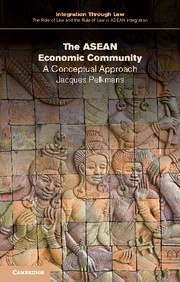Book contents
- Frontmatter
- Contents
- List of figures
- List of tables
- List of boxes
- General editors’ preface
- 1 Introduction and purpose
- 2 Foundations of economic integration fundamentals, stages and credibility
- 3 Conceptual foundation of the ASEAN Economic Community
- 4 Implementation of the AEC: progress in adopting instruments from the Roadmap
- 5 A reality check: comparing the AEC and NAFTA on substance
- 6 Options for the AEC and their practical implications
- 7 Conclusions
- Executive summary
- Appendix 1
- References
- Index
6 - Options for the AEC and their practical implications
Published online by Cambridge University Press: 05 March 2016
- Frontmatter
- Contents
- List of figures
- List of tables
- List of boxes
- General editors’ preface
- 1 Introduction and purpose
- 2 Foundations of economic integration fundamentals, stages and credibility
- 3 Conceptual foundation of the ASEAN Economic Community
- 4 Implementation of the AEC: progress in adopting instruments from the Roadmap
- 5 A reality check: comparing the AEC and NAFTA on substance
- 6 Options for the AEC and their practical implications
- 7 Conclusions
- Executive summary
- Appendix 1
- References
- Index
Summary
Having identified the strategic choices for a credible and effective AEC, and having made the economic case both for ASEAN as the ‘production base’ and for the AEC as a quasi-single market, the question is what are the options for the AEC? Three stylised options will be discussed. The purpose is to stimulate coherence in the AEC design and to identify priorities and trade-offs. Unlike Chapter 4, most details will be avoided. The three options are:
(1) a single-market-minus;
(2) ASEAN as a regional ‘production base’; and
(3) AECasa‘living’ regional market and development compact.
The AEC as a single-market-minus
Understanding the AEC as a deeper and wider form of market integration is an obvious first option. Name and instruments like ‘single market’ (and its ‘free flows’) do suggest this forcefully. Our analysis of the Roadmap and its implementation (in Chapter 4) yields confusing signals. The Roadmap itself would seem to incorporate the right direction with respect to many chapters, but once one zooms in on the details, one finds numerous loose ends, occasional shallowness of cross-border liberalisation and a lack of commitment in several important components. However, its implementation does demonstrate a good deal of progress, too, expressed in new (binding) Agreements (such as ATIGA, ACIA, movements of natural persons, various on air transport, MRAs for professional services, etc.) – which is a significant turn for ASEAN given its traditions – and steady advances in sequential packages of implementation under AFAS, the customs programme and step-wise increasing market access for investment. There is criticism and some mistrust on the part of observers (including in the present project) because the AEC Scoreboard provides only superficial detail, whereas in deeper market integration what counts is precisely unconditional and transparent market access as well as effective implementation in the Member States.
Nevertheless, even here one should not draw hasty conclusions merely by comparing methods of implementation with those of the EU. There is indeed no doubt that implementation methods – including the indispensable surveillance (monitoring) of those national measures and a regime ensuring corrections in the AEC interest – in ASEAN are too weak for the purpose. It is far from easy, and perhaps even impossible, to combine extreme forms of intergovernmentalism (resulting from sensitivities about ‘sovereignty’) with effective regimes of implementation serving the common AEC interest properly.
- Type
- Chapter
- Information
- The ASEAN Economic CommunityA Conceptual Approach, pp. 181 - 195Publisher: Cambridge University PressPrint publication year: 2016

